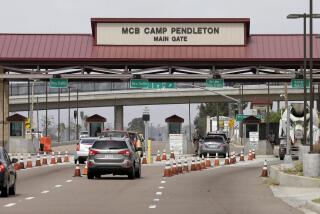Navy Accident Toll Climbs to 102 for ‘89, Highest in Decade : Military: The service has been plagued by a nightmare of fatal incidents. It’s the nature of the business, an admiral says.
- Share via
SAN DIEGO — From the crash two weeks ago of a training pilot into an aircraft carrier, killing five, to Sunday’s accident involving the San Diego-based destroyer Kinkaid, the Navy has been plagued by a nightmare of men killed at sea and in plane crashes.
Lt. Sean Michael McPhee, 24, a navigator from Santa Rosa, Calif., was killed when the Kinkaid collided with a freighter off Malaysia. His death brought the year’s toll to 102 Navy personnel killed during training and standard operating procedures--the highest in the decade--officials said Monday.
Last year, 63 men were killed and there were 69 major accidents. So far in 1989, there have been 67 major accidents involving loss of life or more than $1-million damage to Navy property.
Despite the recent string of accidents, Navy officials said, their personnel are well-trained and maintain a high regard for safety.
“The readiness of today’s naval forces has never been better,” said Adm. C.A.H. Trost, chief of naval operations, in a statement released Monday. “The Navy faces an unforgiving and inherently dangerous environment at sea.
“Despite uncompromising attention to safety procedures and exhaustive training standards, the dangers are always present. And despite our best efforts, accidents do happen,” he said.
Officials pointed out that this year’s death toll includes 47 sailors killed in what they called the bombing of the battleship Iowa last April.
“We do not consider the Iowa an accident,” said. Lt. Greg Smith, a Navy spokesman.
The Navy determined that an explosion aboard the Iowa was an “act of suicide” by Gunner’s Mate Clayton Hartwig, who died in the blast.
Since 1984, an average of 70 men have died each year while serving the Navy.
The collision involving the Kinkaid, one of five accidents in recent days, was part of “what has been a bad couple of weeks for the Navy,” said Cmdr. David Dillon, a spokesman for the commander of the Pacific Fleet in San Diego.
McPhee was killed as he rested in his berth. Five others were injured.
Officials said they have taken the unusual step of installing five telephone lines aboard the vessel to allow sailors to call home in an effort to prop up flagging morale among the crew.
“The crew is working, working to get things back to normal,” said Lt. Cmdr. David Cunningham, who was reached by telephone aboard the ship in Singapore. “I have no idea how long that will take. We’re doing everything possible to make life as normal as possible on board.”
Navy accidents in recent weeks include:
- Thursday, a Navy Reserve jet crashed into a Georgia apartment complex, killing two residents.
- Nov. 1, nine sailors suffered smoke inhalation and four were treated for burns after a boiler fire aboard the tanker Monongahela, about 500 miles west of Gibraltar.
- Oct. 31, three sailors and a reported $4 million of non-nuclear missiles were swept overboard by a wave striking the aircraft carrier Eisenhower near Cape Hatteras, N.C. One sailor is presumed dead.
- Oct. 30, a sailor fell overboard from the aircraft carrier Carl Vinson in the Pacific about 620 miles north of Wake Island and is presumed lost.
- Oct. 30, a pilot dropped a 500-pound bomb on the guided missile cruiser Reeves in the Indian Ocean, causing minor injuries to five sailors.
- On Oct. 29, a training jet crashed aboard the aircraft carrier Lexington in the Gulf of Mexico, killing the pilot and four sailors aboard the vessel.
More to Read
Sign up for Essential California
The most important California stories and recommendations in your inbox every morning.
You may occasionally receive promotional content from the Los Angeles Times.










